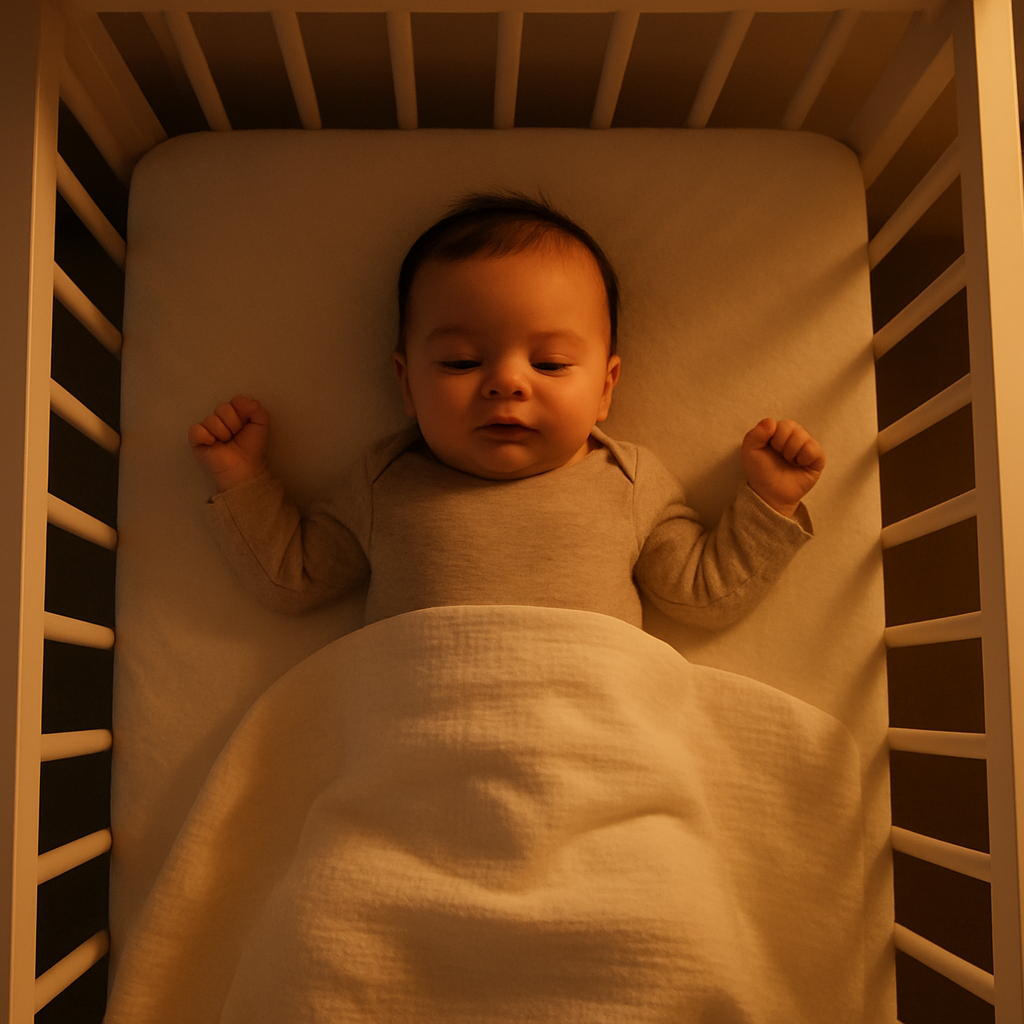Imagine your baby gently drifting off to sleep, not nestled against you, but on a firm, clear mattress where each breath powers millions of new neural connections. During the first year, an infant’s brain forms up to a million synapses every second. Safe sleep practices ensure steady oxygen flow, guarding against risks like carbon dioxide rebreathing. It provides the uninterrupted energy needed to strengthen neurons for learning, memory, and emotional resilience.
Why does safe sleep matter for your baby’s developing brain?
Safe sleep practices lay the foundation for your baby’s brain growth by ensuring steady oxygen flow and reducing risks as in; Sleep and Neurodevelopment. Here’s how they work:
- Back-sleeping protects airways. Placing your baby on their back on a firm, clear surface keeps airways open, maintaining high oxygen levels and reducing SIDS risk by up to 13 times. This oxygen supply supports hippocampal cells vital for memory formation.
- Night wakings are normal. Brief awakenings activate the brainstem’s arousal network, posing no harm to cognition. Studies show no developmental advantage for babies who “sleep through” early; learn more in Sleep Training vs. Night Wakings.
- Room-sharing boosts safety. Sleeping in the same room without bed-sharing cuts sleep-related death risk by up to 50% and helps regulate your baby’s breathing and heart rate through your presence.
- Firm mattresses reduce CO₂ risks. A flat, firm mattress minimizes carbon dioxide build-up, protecting neurons from oxygen deprivation.
- Breastfeeding and pacifiers lower SIDS risk. Both practices reduce SIDS risk, potentially stabilizing heart rhythms during sleep.
By prioritizing these practices, you safeguard your baby’s brain development, fostering learning, memory, and emotional resilience.

How do you create a brain-safe sleep environment step by step?
Follow these steps to ensure your baby’s sleep supports their brain development:
- Select a CPSC-certified crib or bassinet with slats no wider than 2⅜ inches (6 cm) to prevent head entrapment. Learn about crib safety standards.
- Dress your baby in a lightweight onesie and a sleep sack, keeping the room at about 68°F (20°C) to avoid overheating.
- Practice the ABCs—Alone, Back, Crib—and add “D” for daytime tummy time to strengthen the motor cortex. Find age-based sleep needs at Baby Sleep Needs by Age.
- Offer a pacifier once breastfeeding is established (around 3–4 weeks) to reduce SIDS risk.
- Feed on demand, then place your baby back in the crib to promote restorative sleep that fuels brain growth. Explore the science at How Sleep Boosts Your Baby’s Brain.
Which myths or overlooked factors still put baby brains at risk?
Misconceptions and overlooked risks can jeopardize your baby’s brain development. Here’s what to avoid:
- Myth: “Reflux babies need inclined sleepers.” Fact: Angles over 10° increase asphyxia risk without easing reflux. Learn about safe sleep for reflux.
- Smart monitors don’t prevent SIDS. No consumer device stops SIDS, and many have risky cords that can tangle.
- Secondhand smoke harms sleep safety. Exposure increases breathing issues during sleep; keep all sleep areas 100% smoke-free.
- Pressure for all-night sleep backfires. Forcing infants to sleep through the night can cause overtiredness, raising cortisol levels that may hinder brain development. Explore more at Overtired Baby?.
- Repeated mild hypoxia affects brain growth. Recent studies suggest oxygen shortages may impact brain structure, like the corpus callosum, by 12 months.
What if your family’s routine—or relatives—break the rules?
When family habits or relatives challenge safe sleep practices, try these steps to keep your baby’s brain-safe environment on track:
- Model safe sleep practices. Set up the crib in front of visiting grandparents and explain why it protects your baby’s brain, not just the rules. Share a one-page guide listing the ABCs (Alone, Back, Crib) and their brain benefits. Explore more in Rebreathing potential of infant mattresses and bed covers
- Prepare a travel-crib kit. Pack a portable play yard, fitted sheet, and extra sleep sack for holidays or babysitting to ensure a safe sleep setup.
- Handle stroller naps safely. If your baby falls asleep in a stroller, fully recline it, monitor closely, and transfer to a crib as soon as possible.
- Address bed-sharing concerns. For relatives favoring bed-sharing, share Co-Sleeping vs. Crib Safety to discuss safer options and risk-reduction tips.
Your Top Questions, Answered
-
Won’t back-sleeping cause choking if my baby spits up?
No—back-sleeping is the safest position. The trachea sits above the esophagus, so fluids pool away from the airway and are swallowed rather than inhaled. -
Does swaddling delay motor skills?
Proper swaddling up to the first roll does not hinder development. Stop once baby tries to roll; then switch to an arms-free sleep sack. -
Can longer naps replace night sleep?
Naps enhance memory but cannot substitute for nighttime REM. Day sleep complements, not replaces, nocturnal brain repair; details in Why Naps Boost Your Baby’s Memory. -
Is a 2-3-4 schedule necessary for healthy brains?
Flexible, cue-based rhythms work best. Rigid formulas can elevate stress hormones; following sleepy cues respects each baby’s unique circadian maturation. -
When can soft toys enter the crib?
After 12 months. By then, motor control and reduced SIDS risk make a small comfort object safe.
Final Thoughts
Safe sleep is more than crisis prevention; it’s an everyday investment in curiosity, focus, and emotional balance. By pairing clear safety steps with the neuroscience behind them, you turn every nap into brain food. Ready to build the next layer of healthy habits? Explore How to Create a Sleep Routine for Better Baby Brain Health. Rest easy—each safe bedtime is a gift of lifelong learning.